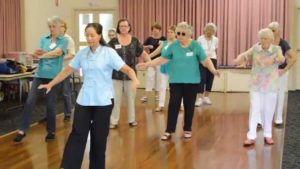
By John M. de Castro, Ph.D.
“A growing body of carefully conducted research is building a compelling case for tai chi as an adjunct to standard medical treatment for the prevention and rehabilitation of many conditions commonly associated with age.” – Peter M. Wayne
Modern medicine has markedly improved the treatments for cancer. But, unfortunately, these treatments themselves can be difficult on the patient and produce great discomfort and suffering. In addition, if the treatment is successful, the cancer survivor is left with a whole different set of challenges. Fatigue accompanies cancer and its treatment in from half to all cancer patients depending upon the type of cancer and treatment regimen. The lasting impact of the cancer and its treatment are particularly evident and dangerous for the elderly. “Senior cancer survivors are a particularly vulnerable population because they have an increased risk for the development or progression of chronic diseases (e.g., cardiovascular, hypertension, stroke, Type 2 diabetes mellitus, arthritis, etc). . . In senior cancer survivors, this is highly relevant as twice as many deaths occur as a result of chronic diseases other than cancer, with cardiovascular disease emerging as a leading cause of death” (Campo et al. 2016).
Tai Chi has been practiced for thousands of years with benefits for health and longevity. Tai Chi training is designed to enhance function and regulate the activities of the body through regulated breathing, mindful concentration, and gentle movements. Only recently though have the effects of Tai Chi practice been scrutinized with empirical research. It has revealed that it is effective for an array of physical and psychological issues. It appears to strengthen the immune system, reduce inflammation and increase the number of cancer killing cells in the bloodstream. All of these effects suggest that Tai Chi may be effective for elderly cancer survivors.
In today’s Research News article “Blood Pressure, Salivary Cortisol, and Inflammatory Cytokine Outcomes in Senior Female Cancer Survivors Enrolled in a Tai Chi Chih Randomized Controlled Trial.” See:
or see summary below or view the full text of the study at:
http://www.ncbi.nlm.nih.gov/pmc/articles/PMC4344390/
Campo and colleagues examine the effectiveness of Tai Chi practice to improve the health of elderly (>= 55 yrs.) female cancer survivors. The women were randomly assigned to receive 12 weeks of Tai Chi practice or Health Education for one hour three times per week. They were measured before and after training for blood pressure, salivary cortisol levels, and inflammatory cytokines. Campo and colleagues found that the Tai Chi group had a significantly greater reduction in systolic blood pressure (12%) and salivary cortisol levels (24%), but not inflammatory cytokines, than the Health Education group.
These are excellent findings. The fact that Tai Chi improved systolic blood pressure suggests that it improved cardiovascular health. This is particularly significant as cardiovascular disease is the greatest threat to the longevity of these vulnerable patients. The fact that Tai Chi reduced the salivary cortisol levels, an indicator of stress, suggests that Tai Chi reduced the levels of physiological stress in these patients which is also associated with decreased health and longevity. Hence, Tai Chi practice lowers chronic illness risk factors in elderly female cancer survivors.
It is known that exercise lowers cardiovascular and stress related risk factors and Tai Chi is a gentle exercise. This may be responsible for its effectiveness. Mindfulness practice is also known to reduce these risk factors. So, it is also possible that this is the reason for the effectiveness of Tai Chi practice. Regardless, Tai Chi is an almost perfect practice for elderly cancer survivors. It is gentle, has virtually no adverse side effects, and can be practiced in groups or alone at home at very low cost.
So, improve elderly cancer survivors’ health with tai chi.
“The gentle approach makes tai chi an ideal physical and mental exercise for cancer patients. The world of cancer treatment is filled with messages that tell patients to fight a war against their cancer, which can make them feel at war with their own bodies. Tai chi is particularly beneficial for anyone affected by cancer because it teaches people to respond peacefully and mindfully to forces out of their control.” – Michelle Whitmer
CMCS – Center for Mindfulness and Contemplative Studies
This and other Contemplative Studies posts are also available on Google+ https://plus.google.com/106784388191201299496/posts
Study Summary
Campo, R. A., Light, K. C., O’Connor, K., Nakamura, Y., Lipschitz, D., LaStayo, P. C., … Kinney, A. Y. (2015). Blood Pressure, Salivary Cortisol, and Inflammatory Cytokine Outcomes in Senior Female Cancer Survivors Enrolled in a Tai Chi Chih Randomized Controlled Trial. Journal of Cancer Survivorship : Research and Practice, 9(1), 115–125. http://doi.org/10.1007/s11764-014-0395-x
Abstract
Purpose: Older cancer survivors are a vulnerable population due to an increased risk for chronic diseases (e.g., cardiovascular disease) compounded with treatment late-effects and declines in physical functioning. Therefore, interventions that reduce chronic disease risk factors (i.e., blood pressure, chronic inflammation, & cortisol) are important in this population. Tai Chi Chih (TCC) is a mind-body exercise associated with reductions in chronic disease risk factors, but has not been examined with older cancer survivors. In a feasibility randomized controlled trial of TCC, we examined secondary outcomes of blood pressure, salivary cortisol, and inflammatory cytokines (interleukin (IL)-6, IL-12, tumor necrosis factor-α, IL-10, IL-4) due to their implications in chronic diseases.
Methods: Sixty-three senior female cancer survivors (Mage=67 years, SD=7.15) with physical functioning limitations (SF-12 physical functioning≤80 or role-physical≤72) were randomized to 12-weeks (60-minutes, three times a week) of TCC or Health Education control (HEC) classes. Resting blood pressure, 1-day salivary cortisol samples, and fasting plasma samples for cytokine multiplex assays were collected at baseline and 1-week post-intervention.
Results: Controlling for baseline values, the TCC group had significantly lower systolic blood pressure (SBP,p=0.002) and cortisol area-under-curve (AUC, p=0.02) at post-intervention than the HEC group. There was no intervention effect on inflammatory cytokines (p’s>0.05).
Conclusions: This TCC feasibility trial was associated with significant reductions in SBP and cortisol AUC in senior female cancer survivors. Larger, definitive trials are needed to confirm these findings.
http://www.ncbi.nlm.nih.gov/pmc/articles/PMC4344390/








